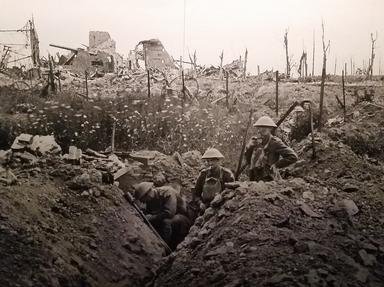Quiz Answer Key and Fun Facts
1. Known to history as "The Lost Battalion," the elements engaged in the Argonne fighting that were subsequently trapped by the German forces were units of what U.S. infantry division?
2. October 2, 1918. The Allied troops, under orders to advance, moved forward through the densely wooded Argonne Forrest. French troops were on the the left flank of the advance, American troops were in the center and the right flank. The flanks stalled. The surrounded contingent came under the command of which U.S. Army officer?
3. The "Lost Battalion" were completely on their own, without support from the American lines and their French allies. How long did their "ordeal" in the Argonne last?
4. As the trapped American troops were completely cut off from all friendly communication, "runners" were dispatched to try to sneak through the German lines and get word back to their Allies. Apparently all runners either became lost, killed, or captured by the Germans. The soldiers finally had to resort to the use of carrier pigeons.
5. Low on food, water, ammunition, and supplies ... and with still no hope of rescue, the Americans fell victim to a "friendly-fire" artillery barrage.
6. October 7, 1918. After five days of being trapped, the Americans endured the most harshest of hardships. There are no more pigeons. The only food left was leftover rice for the pigeons, which was rationed for the wounded. The only fresh water could be taken from a stream within sight of the German lines, susceptible to sniper fire. An American soldier approaches the lines bearing what message?
7. Also on October 7, the Germans launched a ferocious attack. Again, the Americans repulsed the enemy push at their lines. They were tired, hungry, and low on ammunition. German snipers made it impossible to bury the dead around them, and the smell became unbearable. On the evening of the 7th, troops finally came to the aid of the "Lost Battalion." What troops found them?
8. As the sun rose on the sixth day, more help arrived in terms of food and reinforcements. The Germans decided to pull back, and Whittelesy's men could finally breath sighs of relief. 554 officers and men, including Major Charles Whittelesy, originally constituted what became known as the "Lost Battalion." How many men were able to walk out of "The Pocket" after the relief?
9. November 11, 1918. The Armistice was signed, ending hostilities on the Western Front. After occupation duty, the 77th Infantry Division returned to the United States in April, 1919. The division had spent nearly two years overseas! Whittelesy, along with four other men of the "Lost Battalion," was awarded what decoration for valor?
10. In November, 1921 the body of an unknown American soldier was laid to rest "in honored glory" at Arlington National Cemetery. The Tomb of the Unknown Soldier is to represent the sacrifices of Americans killed in action and to honor troops whose bodies remain, to this day, unidentified. Whittelsey was given what honor during the ceremony?
Source: Author
guitarman96
This quiz was reviewed by FunTrivia editor
bloomsby before going online.
Any errors found in FunTrivia content are routinely corrected through our feedback system.

